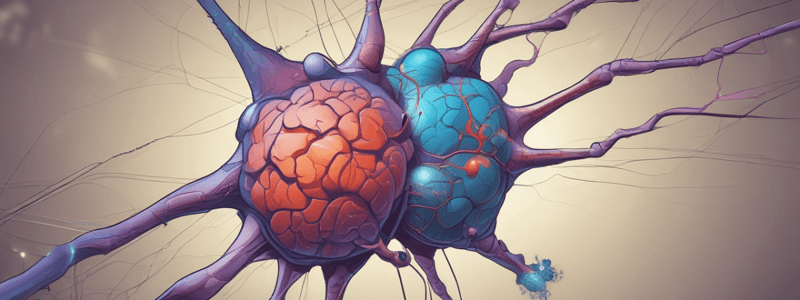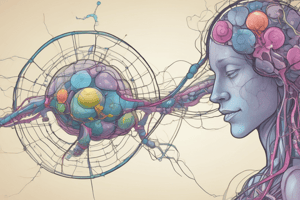Podcast
Questions and Answers
What happens to glucuronides in the GI tract?
What happens to glucuronides in the GI tract?
- They are reabsorbed into the bloodstream
- They are hydrolysed by B-glucuronidase (correct)
- They are excreted into the bile
- They are metabolized by the liver
Tetracyclines should be avoided in pregnant people and young children because they have a high affinity for calcium.
Tetracyclines should be avoided in pregnant people and young children because they have a high affinity for calcium.
True (A)
What is the enzyme responsible for metabolizing ethanol?
What is the enzyme responsible for metabolizing ethanol?
alcohol dehydrogenase
Activated charcoal prevents aspirin overdose by decreasing aspirin absorption as it has ______________ that the drug molecules attach to.
Activated charcoal prevents aspirin overdose by decreasing aspirin absorption as it has ______________ that the drug molecules attach to.
Which of the following is an example of a zero-order kinetics drug?
Which of the following is an example of a zero-order kinetics drug?
Match the following drug transporters with their types:
Match the following drug transporters with their types:
Thiopental is commonly used for anesthesia maintenance.
Thiopental is commonly used for anesthesia maintenance.
What is the mechanism of action of ritonavir as a CYP inhibitor?
What is the mechanism of action of ritonavir as a CYP inhibitor?
What is the action of Salbutamol?
What is the action of Salbutamol?
Paracetamol is an analgesic that inhibits cyclooxygenase.
Paracetamol is an analgesic that inhibits cyclooxygenase.
What is the mechanism of action of Nifedipine?
What is the mechanism of action of Nifedipine?
Fluoxetine is an antidepressant that works by ______________ serotonin re-uptake.
Fluoxetine is an antidepressant that works by ______________ serotonin re-uptake.
Match the following antifungal drugs with their mechanism of action:
Match the following antifungal drugs with their mechanism of action:
What is the mechanism of action of Amphetamine?
What is the mechanism of action of Amphetamine?
Teratogens are agents that cause birth defects.
Teratogens are agents that cause birth defects.
What is the mechanism of action of Chloramphenicol?
What is the mechanism of action of Chloramphenicol?
Ritonavir is a potent ______________ inhibitor used to boost protease inhibitors.
Ritonavir is a potent ______________ inhibitor used to boost protease inhibitors.
What is the mechanism of action of Morphine?
What is the mechanism of action of Morphine?
Study Notes
Adrenergic receptors
- Adrenaline acts on β-adrenoceptors, increasing contractility
- α1, α2, and muscarinic acetylcholine receptors have different actions
- β-adrenoceptors activate adenylate cyclase
- Salbutamol is an agonist at β2-adrenoceptors, relieving bronchospasm
- Mechanism of salbutamol action: binds to β2-adrenoceptor, activates Gs protein, increases adenylate cyclase, and relaxing smooth muscle
Other receptors and drugs
- Acetylcholine acts on muscarinic receptors, stimulating nicotinic receptors
- Noradrenaline acts on α-adrenoceptors, mimicking endogenous ligands
- Phenylephrine activates α-adrenoceptors, causing vasoconstriction
- Diphenhydramine binds to histamine and muscarinic acetylcholine receptors
- Pancuronium is a nicotinic receptor antagonist, used for muscle paralysis
- Insulin activates insulin receptors, lowering blood glucose
- Prednisolone is a glucocorticoid drug, activating nuclear receptors
- Nifedipine blocks Ca2+ channels, treating hypertension
- Benzodiazepines enhance GABA-activated Cl- channel opening, treating anxiety
- Paracetamol inhibits cyclooxygenase, an analgesic
- Fluorouracil blocks DNA synthesis, an anti-cancer drug
- Ciclesonide is a prodrug, converted to an active metabolite in the lung
- Fluoxetine inhibits serotonin re-uptake, an antidepressant
- Amphetamine uses noradrenaline transporters, releasing neurotransmitters
- Ethanol increases drug metabolism, leading to lower plasma concentrations
Neurotransmitters
- GABA is an inhibitory transmitter, forming from glutamate
- Types: GABAa, GABAb (GPCR), GABAc (ion channel receptors)
- Glycine activates ion channel receptors, an inhibitory neurotransmitter
- Glutamate activates ion channel receptors, an excitatory neurotransmitter
- 5-HT activates ion channel receptors, increasing motility and vasodilation
- Suxamethonium is a long-acting agonist, causing neuromuscular block
Teratogens and adverse drug reactions
- Teratogens: agents causing birth defects by altering fetal growth
- Type A ADR: linked to pharmacological effects, showing a dose-response relationship
- Type B ADR: idiosyncratic, unpredictable adverse reactions
- Type D ADR: time-related, occurring after drug use
- Type F ADR: unexpected failure of drugs to produce therapeutic effects
- TOCP causes delayed neuropathy, a human teratogen
- Diethylstilbestrol is a synthetic estrogen, linked to severe birth defects
- Thalidomide causes severe birth defects, a human teratogen
- Fetal alcohol syndrome results from prenatal alcohol exposure
Antibiotics and antifungals
- Penicillin inhibits bacterial cell wall synthesis
- Amoxicillin is a broad-spectrum penicillin, not β-lactamase resistant
- Clavulanic acid is a β-lactamase inhibitor, semisynthetic
- Augmentin is a combination drug for penicillin resistance
- Cephalosporin inhibits bacterial cell wall synthesis
- Aminoglycosides inhibit bacterial protein synthesis, inhibiting initiation
- Tetracyclines inhibit bacterial protein synthesis, inhibiting tRNA binding
- Amphenicols inhibit bacterial protein synthesis, inhibiting transpeptidation
- Antifungal macrolides inhibit protein synthesis, preventing tRNA transfer
- Echinocandin inhibits fungal cell wall synthesis
- Polyenes alter fungal cell membrane integrity
- Allylamines alter fungal cell membrane integrity
- Azoles inhibit ergosterol biosynthesis, altering fungal cell membrane integrity
Enzymes and transporters
- CYP2D6 inhibitor: cimetidine
- Prodrug example: codeine -> morphine (dealkylation)
- Tenofovir disoproxil is a prodrug, hydrolyzed to tenofovir by esterase
- Morphine is metabolized to morphine-3-glucuronide (major) and morphine-6-glucuronide (minor) by UGT2B7
- Enterohepatic recirculation: lipophilic drug undergoes absorption, hepatic metabolism, conjugation, excretion into bile, and reabsorption
- Paracetamol is metabolized to NAPQI by GST
Important notes
- Charcoal prevents aspirin overdose by absorbing the drug, preventing reabsorption
- Sodium bicarbonate prevents salicylate overdose by alkalising urine, increasing ionization, and facilitating excretion
- Important ABC transporters: MDR1, MRP2, BCRP
- Important SLC transporters: OAT1, OAT3
- Ethanol is stored in total body water and metabolized by alcohol dehydrogenase
- Tetracyclines have high affinity for calcium and should be avoided in pregnancy and young children
- Thiopental is not used for anesthesia maintenance due to its lipophilic properties and potential for 'hangover' effect
Studying That Suits You
Use AI to generate personalized quizzes and flashcards to suit your learning preferences.
Description
This quiz covers the pharmacological actions of adrenaline, acetylcholine, noradrenaline, and phenylephrine on different receptors and their effects on various physiological processes.



